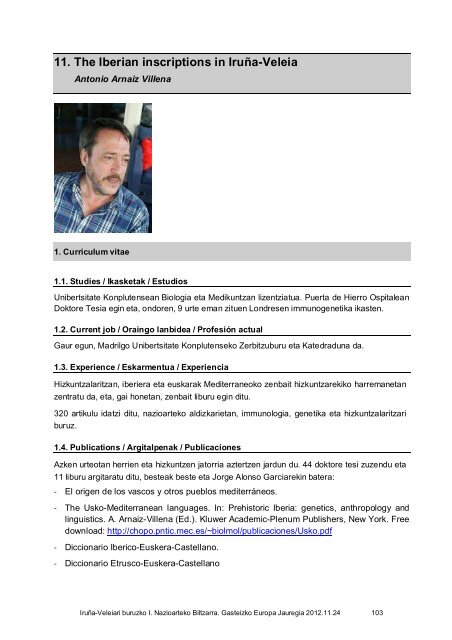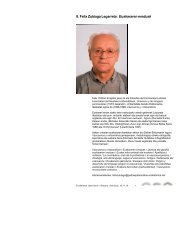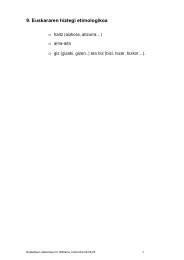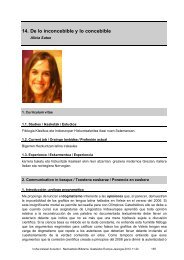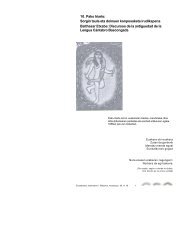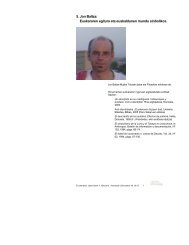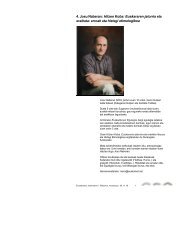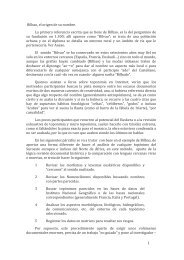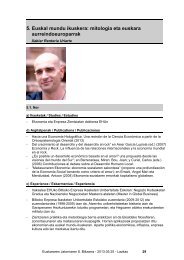11. The Iberian inscriptions in Iruña-Veleia
11. The Iberian inscriptions in Iruña-Veleia
11. The Iberian inscriptions in Iruña-Veleia
You also want an ePaper? Increase the reach of your titles
YUMPU automatically turns print PDFs into web optimized ePapers that Google loves.
<strong>11.</strong> <strong>The</strong> <strong>Iberian</strong> <strong><strong>in</strong>scriptions</strong> <strong>in</strong> Iruña-<strong>Veleia</strong><br />
Antonio Arnaiz Villena<br />
1. Curriculum vitae<br />
1.1. Studies / Ikasketak / Estudios<br />
Unibertsitate Konplutensean Biologia eta Medikuntzan lizentziatua. Puerta de Hierro Ospitalean<br />
Doktore Tesia eg<strong>in</strong> eta, ondoren, 9 urte eman zituen Londresen immunogenetika ikasten.<br />
1.2. Current job / Ora<strong>in</strong>go lanbidea / Profesión actual<br />
Gaur egun, Madrilgo Unibertsitate Konplutenseko Zerbitzuburu eta Katedraduna da.<br />
1.3. Experience / Eskarmentua / Experiencia<br />
Hizkuntzalaritzan, iberiera eta euskarak Mediterraneoko zenbait hizkuntzarekiko harremanetan<br />
zentratu da, eta, gai honetan, zenbait liburu eg<strong>in</strong> ditu.<br />
320 artikulu idatzi ditu, nazioarteko aldizkarietan, immunologia, genetika eta hizkuntzalaritzari<br />
buruz.<br />
1.4. Publications / Argitalpenak / Publicaciones<br />
Azken urteotan herrien eta hizkuntzen jatorria aztertzen jardun du. 44 doktore tesi zuzendu eta<br />
11 liburu argitaratu ditu, besteak beste eta Jorge Alonso Garciarek<strong>in</strong> batera:<br />
- El origen de los vascos y otros pueblos mediterráneos.<br />
- <strong>The</strong> Usko-Mediterranean languages. In: Prehistoric Iberia: genetics, anthropology and<br />
l<strong>in</strong>guistics. A. Arnaiz-Villena (Ed.). Kluwer Academic-Plenum Publishers, New York. Free<br />
download: http://chopo.pntic.mec.es/~biolmol/publicaciones/Usko.pdf<br />
- Diccionario Iberico-Euskera-Castellano.<br />
- Diccionario Etrusco-Euskera-Castellano<br />
Iruña-<strong>Veleia</strong>ri buruzko I. Nazioarteko Biltzarra. Gasteizko Europa Jauregia 2012.<strong>11.</strong>24 103
2. Summary / Laburpena / Resumen<br />
2.1. Summary: <strong>The</strong> <strong>Iberian</strong> <strong><strong>in</strong>scriptions</strong> <strong>in</strong> Iruña-<strong>Veleia</strong><br />
760 officially recognized scripts on ceramics from Iruña-<strong>Veleia</strong> excavated by the archaeology<br />
firm Lurmen S.L. have been analyzed. A number of these ceramics conta<strong>in</strong>s scripts which may<br />
be assimilated to <strong>Iberian</strong>/Tartessian writ<strong>in</strong>gs. This number may be underestimated s<strong>in</strong>ce more<br />
studies need to be done <strong>in</strong> already available and new found ceramics. This is the second time<br />
that <strong>Iberian</strong> writ<strong>in</strong>g is found by us <strong>in</strong> an unexpected location together with the <strong>Iberian</strong>-Guanche<br />
<strong><strong>in</strong>scriptions</strong> of Lanzarote and Fuerteventura (Canary Islands).<br />
On the other hand, naviform script<strong>in</strong>g, usually associated to <strong>Iberian</strong> rock or stone engrav<strong>in</strong>g<br />
may have also been found <strong>in</strong> <strong>Veleia</strong>. Strict separation, other than <strong>in</strong> time and space<br />
stratification, between <strong>Iberian</strong> and (South) Tartessian culture and script is doubted.<br />
<strong>The</strong> Iruña-<strong>Veleia</strong> affair is sufficiently known. <strong>The</strong> precipitation of judgment and the lack of<br />
different and public studies and op<strong>in</strong>ions have obscured and entangled the relevance and<br />
significance of archaeological and epigraphic f<strong>in</strong>d<strong>in</strong>g, particularly those related to ancient<br />
Basque language <strong><strong>in</strong>scriptions</strong>. In addition to the many near impossible oddities that a<br />
hypothetical faker might have gone through, it becomes almost impossible if, <strong>in</strong> addition, he/she<br />
would have properly handled <strong>Iberian</strong> script<strong>in</strong>g.<br />
We have analyzed n=760 ceramic pieces, which are put up on the Araba Diputacion General<br />
page under the head<strong>in</strong>g of “AFADFA.IV_FOTOS_GENERAL_ PIEZAS_PEQUEÑAS”<br />
(www.alava.net/publicar/Fotos/AFADFA_IV_Fotos_General.zip) (Diputación General de Alava,<br />
2011).<br />
Many of the pieces may conta<strong>in</strong> <strong>Iberian</strong> scripts/graffiti but they have been neglected; some of<br />
our f<strong>in</strong>ally taken scripts may also be expla<strong>in</strong>ed by other old Mediterranean scripts, but we are<br />
confident that most of them are written <strong>in</strong> the old <strong>Iberian</strong> script and some of them can strictly be<br />
<strong>Iberian</strong>.<br />
Many authors, Wilheim Humboldt be<strong>in</strong>g the most known, have from Middle Ages believed that<br />
Basque language was a form of ancient <strong>Iberian</strong>, (Basque/ Ancient <strong>Iberian</strong>); this has nowadays<br />
been rediscovered with new methodologies<br />
Fig 1. Note that this sign is not present <strong>in</strong> the Tartessian-Espanca<br />
signary, but it is often present <strong>in</strong> South West “Tartessian”<br />
<strong><strong>in</strong>scriptions</strong>.<br />
Iruña-<strong>Veleia</strong>ri buruzko I. Nazioarteko Biltzarra. Gasteizko Europa Jauregia 2012.<strong>11.</strong>24 104
2.2. Laburpena: Iberiar idazkunak Iruña-<strong>Veleia</strong>n<br />
Iruña-<strong>Veleia</strong>ko arkeologi <strong>in</strong>dusketetatik ofizialki a<strong>in</strong>tzat hartuak izan diren 760 idazkun aztertu<br />
dira, aipatu <strong>in</strong>dusketok Lurmen, S.L. enpresak burutu zituen. Zenbait zeramikek iberiar-tartesiar<br />
idazkunetako ze<strong>in</strong>uak erakusten dituzte. Iberiar-tartesiar idazkun kopurua askoz handiagoa izan<br />
daiteke zeren eta dagoeneko aurkitua izan den eta etorkizunean aurkituko den zeramikan<br />
ikerketa gehiago eg<strong>in</strong> behar baita. Bigarrenez gertatzen da guk espero ez genuen lekuan<br />
topatzea iberiarrez idatzitako <strong>in</strong>skripzioak: Lehenengo eta beh<strong>in</strong> Lanzarote eta Fuerteventurako<br />
Kanariar uharteetako haitzuloetan aurkitutako iberiar-guantxe idazkera identifikatu genuen.<br />
Halaber, Iruña-<strong>Veleia</strong>n idazkun nabiformeak aurkitu dira eta berauek normalean iberiar<br />
idazkerari lotuta doaz. Guk uste dugu Iberieraren eta tartesiarraren arteko desberd<strong>in</strong>tasuna<br />
artifiziotsua dela eta behar bada denbora eta espazioaren arteko aldean duela zergatia.<br />
Iruña-<strong>Veleia</strong>ren kasua ezaguna da. Arrapaladan ibiltzeak eta ikerketa publiko asko eta<br />
desberd<strong>in</strong>ak ez egoteak aurkitutako testuen esanahiak argitzea oztopatu dute, batez ere<br />
euskarazko antz<strong>in</strong>ako idazkunei dagokienez. Guk ikertutako 760 <strong>in</strong>skripzioak Arabako Foru<br />
Aldundian daude ikusgai “Afadfa_IV_FOTOS_GENERAL_PIEZAS_PEQUEÑAS”<br />
(www.alava.net/publicar/fotos/AFADFA_ IV_fotos_General.zip) Diputación General de Alava,<br />
2011).<br />
Iberiar idazkera duten pieza asko ez dira kontuan izan ikerketarako. Guk azkenean hartu ez<br />
ditugun <strong>in</strong>skripzio batzuk mediterraneo beste alfabeto batzuen bidez esplika daitezke. Guk<br />
aukeratu ditugunak iberiar –euskaldunak izateko zalantza gutxikoak izan dira.<br />
Egile askok, euren artean Willheim von Humboltek, baieztatu dute erdi-aroaz geroztik euskara<br />
antz<strong>in</strong>ako iberiarraren forma bat dela. Hau metodologia berriek<strong>in</strong> gaur egun berraurkitu eg<strong>in</strong> da.<br />
Begiratu Iruña-<strong>Veleia</strong>ko pieza honetan Tartesiko-Espanca signarioan<br />
agertzen ez den ze<strong>in</strong>u (gezi) bat agertzen dela,<br />
ba<strong>in</strong>a hego-iberiar <strong>in</strong>skripzio askotan badago.<br />
Iruña-<strong>Veleia</strong>ri buruzko I. Nazioarteko Biltzarra. Gasteizko Europa Jauregia 2012.<strong>11.</strong>24 105
2.3. Resumen: Las <strong>in</strong>scripciones ibéricas de Iruña-<strong>Veleia</strong><br />
Se han estudiado 760 <strong>in</strong>scripciones oficialmente reconocidas procedentes de la excavación<br />
arqueológica de Iruña-<strong>Veleia</strong>, realizada por la empresa Lurmen S.L. Varias cerámicas muestran<br />
<strong>in</strong>scripciones ibérico-tartésicas. El número de <strong>in</strong>scripciones ibero-tartésicas identificado puede<br />
ser mucho mayor porque se necesita que se hagan más estudios en la cerámica ya encontrada<br />
y en la que se encuentre en el futuro. Esta es la segunda vez que la escritura ibérica ha sido<br />
hallada por nosotros en un sitio <strong>in</strong>esperado: primeramente identificamos la escritura rupestre<br />
ibero-guanche en las islas Canarias de Lanzarote y Fuerteventura.<br />
Asimismo, se han encontrado <strong>in</strong>scripciones nabiformes en <strong>Veleia</strong>, que generalmente están<br />
asociadas a la escritura ibérica. Nosotros encontramos que la dist<strong>in</strong>ción entre el ibérico y el<br />
tartésico es artificiosa y quizá solamente debida a diferencias en el espacio y en el tiempo.<br />
El caso de Iruña-<strong>Veleia</strong> es conocido. La precipitación y la falta de estudios públicos y diferentes<br />
han dificultado las conclusiones del significado de los hallazgos, particularmente aquellos<br />
relacionados con las <strong>in</strong>scripciones antiguas en lengua vasca. Las 760 <strong>in</strong>scripciones estudiadas<br />
por nosotros, están expuestas en la Diputación General de Alava<br />
“AFADFA.IV_FOTOS_GENERAL_ PIEZAS_PEQUEÑAS”<br />
(www.alava.net/publicar/Fotos/AFADFA_IV_Fotos_General.zip) (Diputación General de Alava,<br />
2011).<br />
Muchas de las piezas que contienen escritura ibérica no se las ha tenido en cuenta para<br />
estudios. Algunas de las <strong>in</strong>scripciones que nosotros no hemos tomado f<strong>in</strong>almente, pueden ser<br />
explicadas por otros alfabetos mediterráneos. Nosotros hemos elegido las que cabe poca duda<br />
de que sean ibérico-vascas.<br />
Muchos autores, el más conocido de ellos Willheim von Humboldt, han afirmado desde tiempos<br />
medievales que la lengua vasca era una forma del ibérico antiguo. Esto se ha redescubierto<br />
hoy día con las nuevas metodologías.<br />
Pág 94 – Pié de pág<strong>in</strong>a de la foto “Nótese que en esta pieza de Iruña-<strong>Veleia</strong><br />
aparece un signo (flecha) que no está presente en el signario Tartésico-Espanca<br />
(considerado un alfabeto Tartésico), pero está presente en muchas <strong>in</strong>scripciones sud-ibéricas.“<br />
Esta ponencia ha sido publicada, con ligeras modificaciones, también en”International Journal<br />
of Modern Anthropologgy” y es descargable s<strong>in</strong> coste en<br />
http://www.ajol.<strong>in</strong>fo/<strong>in</strong>dex.php/ijma/article/view/76786<br />
Iruña-<strong>Veleia</strong>ri buruzko I. Nazioarteko Biltzarra. Gasteizko Europa Jauregia 2012.<strong>11.</strong>24 106
3. Communication / Txostena / Ponencia<br />
3.1. Summary<br />
760 officially recognized scripts on ceramics from Iruña-<strong>Veleia</strong> excavated by the archaeology<br />
firm Lurmen S.L. have been analyzed. A number of these ceramics conta<strong>in</strong>s scripts which may<br />
be assimilated to <strong>Iberian</strong>/Tartessian writ<strong>in</strong>gs. This number may be underestimated s<strong>in</strong>ce more<br />
studies need to be done <strong>in</strong> already available and new found ceramics. This is the second time<br />
that <strong>Iberian</strong> writ<strong>in</strong>g is found by us <strong>in</strong> an unexpected location together with the <strong>Iberian</strong>-Guanche<br />
<strong><strong>in</strong>scriptions</strong> of Lanzarote and Fuerteventura (Canary Islands).<br />
On the other hand, naviform script<strong>in</strong>g, usually associated to <strong>Iberian</strong> rock or stone engrav<strong>in</strong>g<br />
may have also been found <strong>in</strong> <strong>Veleia</strong>. Strict separation, other than <strong>in</strong> time and space<br />
stratification, between <strong>Iberian</strong> and (South) Tartessian culture and script is doubted.<br />
3.2. Introduction and methodology<br />
<strong>The</strong> Iruña-<strong>Veleia</strong> affair is sufficiently known (1). <strong>The</strong> precipitation of judgment and the lack of<br />
different and public studies and op<strong>in</strong>ions have obscured and entangled the relevance and<br />
significance of archaeological and epigraphic f<strong>in</strong>d<strong>in</strong>g, particularly those related to ancient<br />
Basque language <strong><strong>in</strong>scriptions</strong>. In addition to the many near impossible oddities that a<br />
hypothetical faker might have gone through, it becomes almost impossible if, <strong>in</strong> addition, he/she<br />
would have properly handled <strong>Iberian</strong> script<strong>in</strong>g.<br />
We have analyzed n=760 ceramic pieces, which are put up on the Araba Diputacion General<br />
page under the head<strong>in</strong>g of “AFADFA.IV_FOTOS_GENERAL_ PIEZAS_PEQUEÑAS”<br />
(www.alava.net/publicar/Fotos/AFADFA_IV_Fotos_General.zip) (Diputación General de Alava,<br />
2011).<br />
Many of the pieces may conta<strong>in</strong> <strong>Iberian</strong> scripts/graffiti but they have been neglected; some of<br />
our f<strong>in</strong>ally taken scripts may also be expla<strong>in</strong>ed by other old Mediterranean scripts, but we are<br />
Iruña-<strong>Veleia</strong>ri buruzko I. Nazioarteko Biltzarra. Gasteizko Europa Jauregia 2012.<strong>11.</strong>24 107
confident that most of them are written <strong>in</strong> the old <strong>Iberian</strong> script and some of them can strictly be<br />
<strong>Iberian</strong> (3).<br />
Many authors, Wilheim Humboldt be<strong>in</strong>g the most known, have from Middle Ages believed that<br />
Basque language was a form of ancient <strong>Iberian</strong>, (Basque/ Ancient <strong>Iberian</strong>); this has nowadays<br />
been rediscovered with new methodologies<br />
At the moment, we stick to Manuel Gómez Moreno and Antonio Tovar <strong>Iberian</strong> scripts<br />
transliteration (10,11,12,13) and decl<strong>in</strong>e to follow the strange derivation taken by Rodríguez<br />
Ramos and Correa (9,14) <strong>in</strong> redef<strong>in</strong><strong>in</strong>g <strong>Iberian</strong> transliterations and even try<strong>in</strong>g to def<strong>in</strong>e a new<br />
language, “Tartessian”, which cannot be separated from <strong>Iberian</strong> at present as a different<br />
language. <strong>The</strong>ir lack of objectivity is reflected, for example, <strong>in</strong> (15,16):<br />
(which is not conta<strong>in</strong>ed <strong>in</strong> the Espanca signary but appears often <strong>in</strong> “Tartessian” <strong><strong>in</strong>scriptions</strong>) is<br />
converted quite subjectively <strong>in</strong> sound “R”. It does not fit with previous archeo-epigraphic f<strong>in</strong>d<strong>in</strong>gs<br />
(16). This letter has been found <strong>in</strong> Iruña-<strong>Veleia</strong> ceramics 11260, as shown above. (Fig. 1).<br />
3.3. Discussion<br />
<strong>Iberian</strong> scripts f<strong>in</strong>d<strong>in</strong>gs cover most of <strong>Iberian</strong> Península geography. It is clear that from an<br />
archeological po<strong>in</strong>t of view it is not possible to dist<strong>in</strong>guish <strong>in</strong> Iberia and southern France different<br />
signs by a dist<strong>in</strong>ct geography. Most <strong>Iberian</strong> signs do not follow geographical<br />
compartmentalization. Perhaps one or some of them are most often found <strong>in</strong> one particular<br />
archeological site or region; however, once future script sites and f<strong>in</strong>d<strong>in</strong>gs are expected to<br />
appear, it is not objective to def<strong>in</strong><strong>in</strong>g one particular <strong>Iberian</strong>-Tartessian script by classify<strong>in</strong>g it by<br />
geography.<br />
This time stratification implies the use of different writ<strong>in</strong>g supports (metal, stone, ceramics, rock<br />
wall) that cannot be taken has a particular and fundamental dist<strong>in</strong>ction, i.e.: assum<strong>in</strong>g existence<br />
of different languages because of they are on different supports. On the other hand, the so<br />
called “Tartessian” language needs to be revised <strong>in</strong> tim<strong>in</strong>g and <strong>in</strong> space (15) s<strong>in</strong>ce this k<strong>in</strong>d of<br />
scripts are also found <strong>in</strong> North Caceres (Monfragüe), a quite high and central place <strong>in</strong> <strong>Iberian</strong><br />
Pen<strong>in</strong>sula for be<strong>in</strong>g considered “Tartessian-South West” script-language; “Tartessian” scripts<br />
are also found <strong>in</strong> the Spanish South-East (18).<br />
Even, a “Tartessian” – specific sign is found <strong>in</strong> northernmost part of Spa<strong>in</strong> (Asturias) (Fig. 2;<br />
Refs 5,6). Also, different time stratums are supposed to exist and a k<strong>in</strong>d of “dialectal” undef<strong>in</strong>ed<br />
way of writ<strong>in</strong>g is also assumed <strong>in</strong> different archeological sites. <strong>Iberian</strong>-Tartessian scripts can be<br />
Iruña-<strong>Veleia</strong>ri buruzko I. Nazioarteko Biltzarra. Gasteizko Europa Jauregia 2012.<strong>11.</strong>24 108
found <strong>in</strong> Galicia (reported by Gabriel Puig Larraz <strong>in</strong> BRAH, pp 414-426. 1897), Asturias (Fig.2;<br />
Ref 6), Portugal and many parts of <strong>Iberian</strong> Península from North to South and East to West.<br />
Tartessian jewelry is widespread throughout <strong>Iberian</strong> pen<strong>in</strong>sula, like Cáceres, Alicante-Villena<br />
and probably North West Asturias (6,7).<br />
(see: www.alava.net/publicar/Fotos/AFADFA_IV_Fotos_General.zip)<br />
<strong>The</strong> problem of different phonologies for the same scripts <strong>in</strong> different sites is not yet resolved<br />
(16,18). Methodology for phoneme assignation is not standardized and each scholar has his<br />
own <strong>in</strong>terpretation (16). This reference is only given for a particular grapheme ( ), however,<br />
Untermann has more author discrepancies <strong>in</strong> <strong>Iberian</strong> signs phonology (19).<br />
We are not go<strong>in</strong>g to further discuss about Iruña-<strong>Veleia</strong> Basque graffiti, which are valid for us<br />
(20), but only to report that also <strong>Iberian</strong> scripts are found <strong>in</strong> <strong>Veleia</strong> ceramics. This makes very<br />
difficult to hold the view that studies <strong>in</strong> Iruña-<strong>Veleia</strong> epigraphy should stop, because there is no<br />
objective reason to end now their Basque or <strong>Iberian</strong> scripts/graffiti studies, for example.<br />
Redundancy rule of vocals after syllables is not a characteristic of a hypothetical “Tartessian”<br />
language, because it does not occur universally (15).<br />
<strong>The</strong> artificial “Tartessian” language separation from <strong>Iberian</strong> language is at the moment another<br />
hypothesis, which is weakly based on objective terms. In addition, some signs not present <strong>in</strong> the<br />
Espanca signary are <strong>in</strong>vented ”ad hoc”, when it is considered necessary by some authors<br />
(14,15), and some of the Espanca “Tartessian” syllables-letters are never used <strong>in</strong> the South<br />
West script.<br />
On these confus<strong>in</strong>g bases, we th<strong>in</strong>k it is better at the moment to stick <strong>in</strong> our hypotheses for<br />
Basque-<strong>Iberian</strong> translations/transliterations or otherwise, to the <strong>in</strong>itial Gómez Moreno and Tovar<br />
transliteration (10,11,12,13). We also oppose the concept that <strong>Iberian</strong> and Tartessian are<br />
altogether different languages until it may be objectively demonstrated, if ever.<br />
Iruña-<strong>Veleia</strong>ri buruzko I. Nazioarteko Biltzarra. Gasteizko Europa Jauregia 2012.<strong>11.</strong>24 109
On the other hand, <strong>Veleia</strong> scripts of “Y” type may be assimilated to Lycian, Greek or other<br />
orig<strong>in</strong>s and “X” to Etruscan or Lat<strong>in</strong> orig<strong>in</strong> (Appendix 1, 3). However, the context and/or<br />
attributed time (III century AD) goes <strong>in</strong> favour that these scripts belong to <strong>Iberian</strong> signary. Other<br />
scripts are <strong>Iberian</strong> (CARP-1[Nº2], [Nº7], [Nº29], [Nº38], [Nº41], etc. This is the second time that<br />
we have found <strong>Iberian</strong> scripts <strong>in</strong> a unexpected location: Guanche-<strong>Iberian</strong> rock graffiti are also<br />
found <strong>in</strong> Fuerteventura and Lanzarote (Canary Islands) (21<br />
http://en.wikipedia.org/wiki/File:<strong>Iberian</strong>-Guanche_<strong><strong>in</strong>scriptions</strong>.pdf).<br />
F<strong>in</strong>ally the last piece, CARP-3[Nº8], may be an example of the so called “naviform” graffiti,<br />
which are found on rocks or stone-like pieces <strong>in</strong> Cerdaña and Andorra (Pyrenees) and Corsica<br />
(22). <strong>The</strong>se “naviform” graffiti are usually shown associated to <strong>Iberian</strong> signs (22).<br />
3.4. Notes and references<br />
a) Note<br />
This report has been published, with slight modifications, on this website:<br />
”International Journal of Modern Anthropologgy”<br />
http://www.ajol.<strong>in</strong>fo/<strong>in</strong>dex.php/ijma/article/view/76786<br />
Iruña-<strong>Veleia</strong>ri buruzko I. Nazioarteko Biltzarra. Gasteizko Europa Jauregia 2012.<strong>11.</strong>24 110
Iruña-<strong>Veleia</strong>ri buruzko I. Nazioarteko Biltzarra. Gasteizko Europa Jauregia 2012.<strong>11.</strong>24 111
Iruña-<strong>Veleia</strong>ri buruzko I. Nazioarteko Biltzarra. Gasteizko Europa Jauregia 2012.<strong>11.</strong>24 112
Iruña-<strong>Veleia</strong>ri buruzko I. Nazioarteko Biltzarra. Gasteizko Europa Jauregia 2012.<strong>11.</strong>24 113
) References<br />
1) www.sos-irunaveleia.org<br />
2) Url of ”Diputación General de Álava” (Araba)<br />
www.alava.net/publicar/Fotos/AFADFA_IV_Fotos_General.zip<br />
3) <strong>The</strong> World writ<strong>in</strong>g systems. Editors: P I Daniels and W Bright. 1996. Oxford University<br />
Press. New York (USA).<br />
4) Humboldt W. 1990. Los primitivos habitantes de España. Ed. Polifemo. Madrid (Spa<strong>in</strong>).<br />
5) Arnáiz-Villena A y Alonso-García J. 1999. El origen de los vascos y otros pueblos<br />
mediterráneos. Ed. Complutense. Madrid (Spa<strong>in</strong>) and (2011). Ed. VisionLibros. Madrid<br />
Iruña-<strong>Veleia</strong>ri buruzko I. Nazioarteko Biltzarra. Gasteizko Europa Jauregia 2012.<strong>11.</strong>24 114
(Spa<strong>in</strong>).<br />
6) Prehistoric Iberia: genetics, anthropology, and l<strong>in</strong>guistics. 2000. Chapter 9: <strong>The</strong> Usko-<br />
Mediterranean languages by Arnaiz-Villena A. and Alonso-García J. Editor: Kluwer-Plenum.<br />
New York (USA). Free download http://chopo.pntic.mec.es/~biolmol/publicaciones/Usko.pdf and<br />
page 193<br />
for the “Tartessian–specific” character from Asturias and “Tartessian” jewelry from Asturias.<br />
7) Maluquer de Motes, J. 1970. Tartessos. Ed. Dest<strong>in</strong>o. Barcelona (Spa<strong>in</strong>).<br />
8) Arnáiz-Villena A. and Alonso-García J. 2008. Diccionario Iberico-Euskera-Castellano. Ed<br />
Fundación de Estudios Genéticos y L<strong>in</strong>güísticos. Madrid (Spa<strong>in</strong>).<br />
9) Rodríguez Ramos J. 2004. Análisis de epigrafía ibera. Ed. Universidad del Pais<br />
Vasco/EHU. pp 289-304. Vitoria/Gasteiz.<br />
10) Gómez Moreno M. 1949. Las lenguas hispánicas. Discurso de recepción en la Real<br />
Academia Española, Madrid (Spa<strong>in</strong>).<br />
11) Gómez Moreno M. 1962. La escritura bardulo-turdetana. Ed.Primitiva Hispánica. Madrid<br />
(Spa<strong>in</strong>).<br />
12) Tovar A. 1951. Léxico de las <strong>in</strong>scripciones ibéricas. Estudios dedicados a Menéndez Pidal,<br />
II, pp 273-323. Madrid (Spa<strong>in</strong>).<br />
13) Tovar A. 1955. Sobre las escrituras tartesia, líbico-fenicia y del Algarbe. Zephyrus VI, pp<br />
273-283.<br />
14) Correa JA. 2005. Del alfabeto fenicio al semisilabario paleohispánico. Paleohispánica 5: pp<br />
137-144.<br />
15) Correia VH. 2009. A escrita do sudoeste: uma visao retrospectiva e prospectiva.<br />
Paleohispánica 9, pp 309-321.<br />
16) Fletcher Valls D. 1993-94. Valores fonéticos atribuidos al grafema del alfabeto iberico<br />
del S.E. AnMurcia, 9-10: pp 135-138.<br />
17) Arribas A. 1976. Los Iberos. Ed: AYMA. Barcelona (Spa<strong>in</strong>).<br />
18) Pérez Rojas M. 1993. Las <strong>in</strong>scripciones con escritura tartésica de la cueva de La Camareta<br />
y su contexto onomástico. Antig. Crist. (Murcia). X. pp 139-266.<br />
19) Untermann J. 1990. Monumenta L<strong>in</strong>guarum Hispanicarum. Band III. Page 258. Edited by<br />
L.R. Verlag. Wiesbaden (Germany).<br />
20) Arnaiz-Villena A. 2010-20<strong>11.</strong>Video and pdf of “<strong>Iberian</strong> scripts <strong>in</strong> Iruña-<strong>Veleia</strong> and<br />
Iruña/Pamplona”. (a) http://www.youtube.com/watch?v=U5pRmeiKBVI<br />
(b) http://chopo.pntic.mec.es/biolmol/publicaciones/KMKDONO+Z.pdf<br />
21) (a)Arnaiz-Villena A. and Alonso García J. 20<strong>11.</strong> Egipcios, Bereberes, Guanches y Vascos<br />
(Nueva Edición).Ed Vision Libros. Madrid (Spa<strong>in</strong>).<br />
(b) Arnaiz-Villena A. and Alonso-Garcia J. http://en.wikipedia.org/wiki/File:<strong>Iberian</strong>-<br />
Guanche_<strong><strong>in</strong>scriptions</strong>.pdf<br />
22) Campmajo P and Crabol D. 2009. Les grattages naviformes ont-ils des origenes ibères?<br />
Questions sur leur signification. Acta paleohispánica X. Paleohispánica 9. pp 381-412.<br />
Iruña-<strong>Veleia</strong>ri buruzko I. Nazioarteko Biltzarra. Gasteizko Europa Jauregia 2012.<strong>11.</strong>24 115


